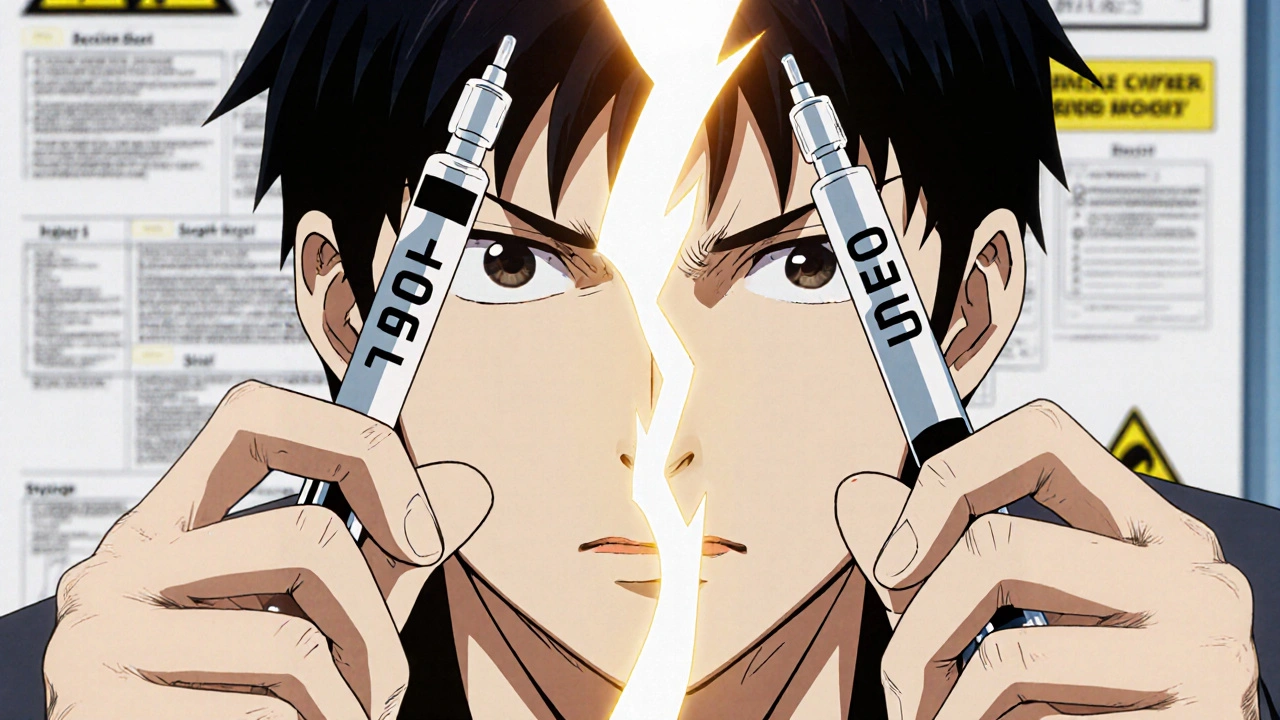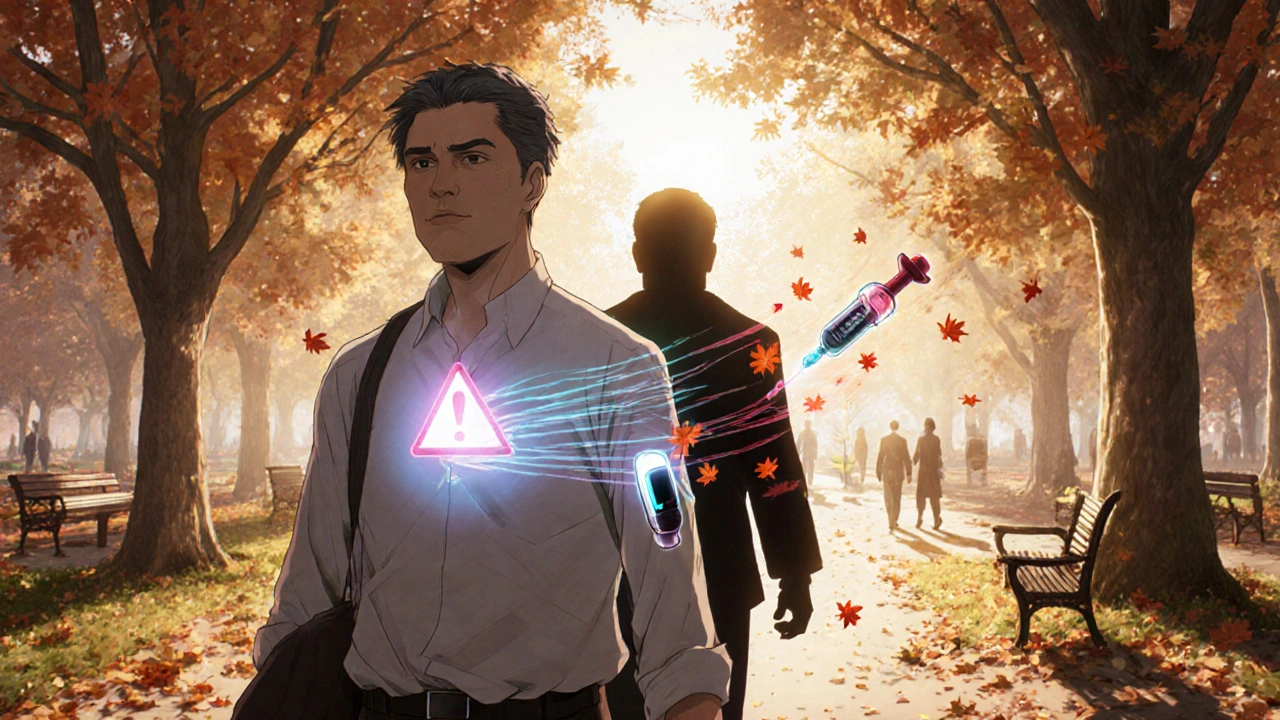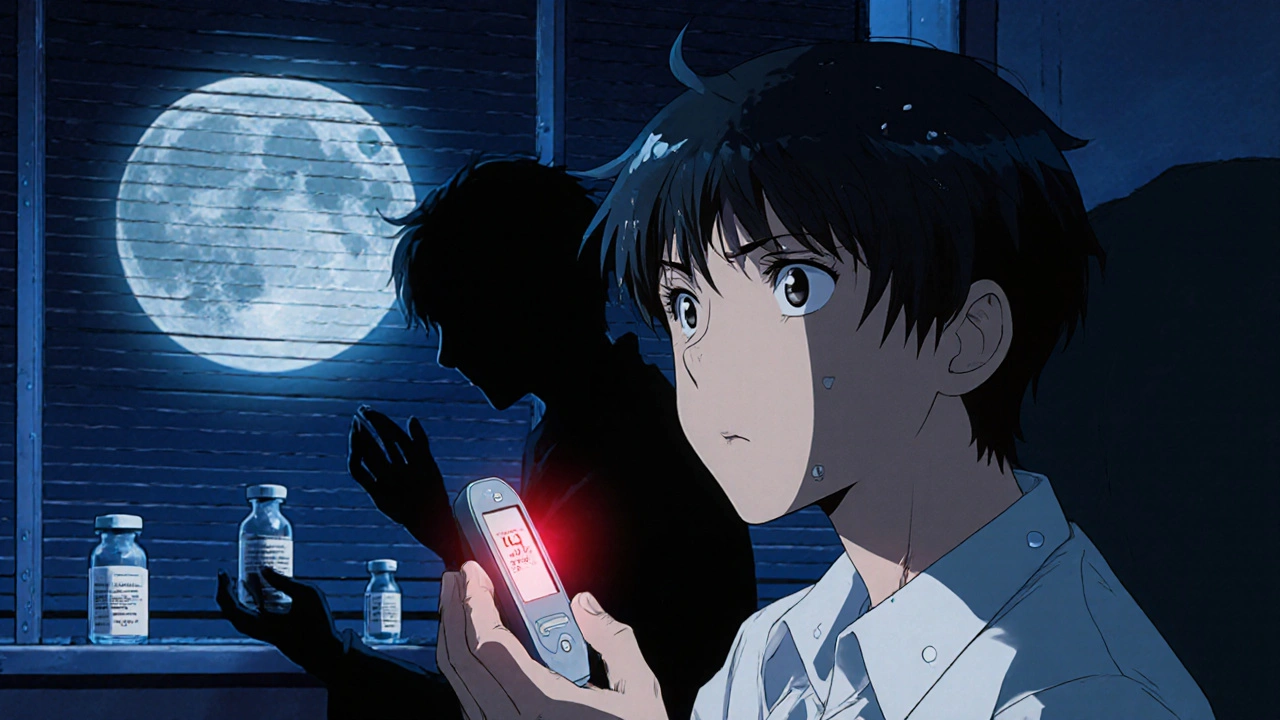Managing diabetes isn’t just about taking pills or injecting insulin-it’s about staying safe while doing it. Every year, thousands of people end up in emergency rooms because of medication mistakes. Some take too much insulin. Others don’t realize their blood sugar is dropping while they sleep. A few start a new antibiotic and suddenly feel dizzy, confused, or faint. These aren’t rare events. They’re preventable-if you know what to watch for.
What’s Really Going On With Your Blood Sugar?
Diabetes medications work in different ways. Some tell your body to make more insulin. Others help your body use insulin better. Some block sugar from being absorbed in your gut. And insulin itself? It’s the only medication that directly lowers blood sugar by letting glucose into your cells. But here’s the catch: insulin and certain oral drugs can drop your blood sugar too low. That’s called hypoglycemia. And it’s the most dangerous side effect of diabetes treatment.Studies show that 20-40% of people on sulfonylureas (like glipizide or glyburide) experience low blood sugar at least once. For 1-7% of them, it’s severe enough that they need someone else to help-like calling 911 or giving a glucagon shot. Even worse, about 30% of people with well-controlled type 2 diabetes on these drugs have silent nighttime lows. No sweating. No shaking. No warning. Just a dangerous drop while they sleep.
Insulin: Powerful, But Easy to Mess Up
Insulin isn’t one thing. It comes in different types, each with its own timing and risk profile. Rapid-acting insulins (like lispro or aspart) start working in 15 minutes and last 3-5 hours. Long-acting ones (like glargine or degludec) last up to 42 hours. Then there’s Humulin R U-500-a concentrated form five times stronger than regular insulin. People mix them up. They think it’s the same as U-100. It’s not. One wrong injection can send blood sugar crashing.Injection technique matters too. Injecting into muscle instead of fat? That speeds up absorption and raises hypoglycemia risk. Not rotating injection sites? That causes lumps under the skin that mess with how insulin gets absorbed. Even the temperature of the insulin can change how fast it works. Keep it at room temperature if you’re using it soon. Cold insulin stings more and can delay absorption.
Automated insulin delivery systems (AID) are changing the game. These devices-sometimes called “artificial pancreas” systems-adjust insulin doses every 5 minutes based on real-time glucose readings. In clinical trials, they’ve cut hypoglycemia by up to 40% compared to traditional pumps. But they’re not magic. You still need to understand how they work, what alarms mean, and when to override them.
Oral Medications: Not All Are Created Equal
Metformin is the most prescribed diabetes pill in the world. It’s safe for most people, doesn’t cause low blood sugar, and may even help with weight. But if your kidneys aren’t working well, it can build up and cause lactic acidosis-a rare but deadly condition. The FDA says don’t start metformin if your eGFR is below 30. Use it carefully if it’s between 30 and 45. And if it’s 45-60, lower the dose.Sulfonylureas? High risk. They force your pancreas to pump out insulin no matter what. That’s great for lowering sugar-but dangerous if you skip a meal, drink alcohol, or get sick. Glipizide is the safest sulfonylurea for older adults or those with kidney issues because it doesn’t build up in the body like glyburide does.
Newer drugs like SGLT2 inhibitors (empagliflozin, dapagliflozin) and GLP-1 agonists (semaglutide, liraglutide) are popular because they help your heart and kidneys. But they come with new risks. SGLT2 inhibitors can trigger diabetic ketoacidosis-even when your blood sugar isn’t sky-high. That’s called euglycemic DKA. It’s rare, but deadly. You’re at higher risk if you’re sick, fasting, or having surgery. The American Association of Clinical Endocrinologists says stop these drugs at least 24 hours before any planned surgery.
GLP-1 agonists often cause nausea, vomiting, or diarrhea-especially when you start or increase the dose. About half of users feel this way at first. Most get used to it. But if you can’t keep food down, your blood sugar can swing wildly. That’s why doctors start low and go slow.

Drug Interactions You Can’t Ignore
Many common medicines can mess with your diabetes drugs. Antibiotics like sulfamethoxazole/trimethoprim can make insulin and sulfonylureas work too hard. Beta-blockers can hide the symptoms of low blood sugar-so you won’t feel your heart racing or sweating. That’s terrifying because you won’t know to treat it.Quinine (for leg cramps), sunitinib (a cancer drug), and somatostatin analogues (used for hormonal disorders) all increase hypoglycemia risk. Even some herbal supplements like bitter melon or fenugreek can lower blood sugar. If you’re taking anything new-prescription, over-the-counter, or supplement-ask your pharmacist: “Could this affect my diabetes meds?”
Special Risks for Older Adults
People over 65 are more likely to have severe hypoglycemia. Why? Their bodies don’t release counter-hormones like glucagon as well. Their kidneys clear drugs slower. They might be on five or six other meds. And they’re more likely to fall if they get dizzy or confused.Dizziness from low blood sugar can lead to fractures, head injuries, or hospitalization. In fact, 25% of all medication-related hospital stays in diabetics happen in people over 65. That’s why doctors now recommend looser blood sugar targets for older adults. HbA1c below 7.5% is often enough. Tighter control doesn’t add years-it adds risk.
Start low. Go slow. Use glipizide instead of glyburide. Avoid long-acting sulfonylureas. Skip drugs that cause dizziness. And always keep fast-acting sugar nearby-glucose tablets, juice, or candy. Make sure a family member knows how to give glucagon.

What You Can Do Right Now
1. Know your meds. Write down every drug you take-name, dose, time, reason. Use a pill organizer if you need to. 2. Check your blood sugar more often. Especially when you’re sick, changing meds, or starting something new. Nighttime lows are silent. Check before bed if you’re on insulin or sulfonylureas. 3. Never skip meals. Especially if you’re on insulin or sulfonylureas. Even a light snack helps. 4. Watch for signs of DKA. Nausea, vomiting, stomach pain, fruity breath, confusion. Even if your sugar isn’t high. Go to the ER if this happens. 5. Carry medical ID. A bracelet or card that says “Diabetic on insulin/oral meds.” Include emergency contact and your most critical meds. 6. Get your eGFR tested yearly. If you’re on metformin or SGLT2 inhibitors, kidney function changes. Don’t wait for symptoms. 7. Ask about AID systems. If you’re on multiple daily injections and still having lows, talk to your doctor. These systems are safer and easier than you think.When to Call Your Doctor
Don’t wait until you’re in crisis. Call if:- You’ve had two or more low blood sugar episodes in a week, even if you treated them.
- You feel dizzy, confused, or faint often-even if your sugar is normal.
- You’re vomiting or can’t keep food down for more than 12 hours.
- Your urine smells fruity or you’re breathing fast.
- You’ve started a new medication and your blood sugar is acting strange.
These aren’t “wait and see” situations. They’re red flags.
Technology Is Helping-But You Still Need to Be In Control
Continuous glucose monitors (CGMs) are now standard for many people on insulin. They show trends, not just numbers. You can see if your sugar is dropping fast-even while you sleep. Some CGMs even alert you before you hit a low. That’s life-changing.But technology doesn’t replace knowledge. You still need to know how to interpret the data. You still need to know how to adjust food, activity, or meds. And you still need to know when to get help.
The goal isn’t perfect numbers. It’s staying safe. It’s waking up tomorrow. It’s walking without falling. It’s living without fear of a silent crash.
Can I take metformin if I have kidney problems?
It depends on how bad your kidney function is. If your eGFR is below 30, you shouldn’t take metformin. If it’s between 30 and 45, your doctor might let you take it but at a lower dose. If it’s 45-60, you can usually stay on it but need regular monitoring. Never start or change metformin without checking your eGFR first.
Is it safe to use SGLT2 inhibitors if I’m planning surgery?
No. You must stop SGLT2 inhibitors at least 24 hours before any surgery-elective or emergency. These drugs can cause diabetic ketoacidosis even when your blood sugar looks normal. This is called euglycemic DKA, and it’s hard to detect without testing. Stopping them reduces this risk significantly.
Why do I keep getting yeast infections with my SGLT2 inhibitor?
SGLT2 inhibitors make your body flush sugar out through urine. That sugar feeds yeast in the genital area, leading to infections. About 4-5% of users get them, especially women. Keep the area clean and dry. If you get recurrent infections, talk to your doctor. You might need antifungal treatment or a switch to another medication.
Can alcohol cause low blood sugar with diabetes meds?
Yes, especially with insulin or sulfonylureas. Alcohol blocks your liver from releasing stored glucose. That means if you drink on an empty stomach or after taking your meds, your blood sugar can crash. Always eat when drinking. Limit to one drink per day. Never drink if you’re already low or planning to sleep soon.
What should I do if I accidentally take too much insulin?
Act fast. Eat 15-20 grams of fast-acting sugar-glucose tablets, juice, or candy. Check your blood sugar in 15 minutes. If it’s still low, repeat. Stay awake and keep checking every 15-30 minutes for the next 4-6 hours. If you feel confused, can’t eat, or are vomiting, call emergency services. Don’t wait. Glucagon can be lifesaving if someone else is available to give it.
Are newer diabetes drugs safer than older ones?
They’re safer for your heart and kidneys, but not necessarily for hypoglycemia. GLP-1 agonists and SGLT2 inhibitors rarely cause low blood sugar on their own. But they’re not risk-free. SGLT2 inhibitors can cause DKA. GLP-1 drugs can cause severe nausea. Metformin and sulfonylureas have been around longer, so we know their risks better. Newer isn’t always safer-it’s just different.
What’s the biggest mistake people make with insulin?
Mixing up insulin types-especially U-500 and U-100. People think they’re the same. They’re not. U-500 is five times stronger. One mistake can cause a life-threatening overdose. Also, injecting into muscle instead of fat, not rotating sites, or using cold insulin can all lead to unpredictable absorption. Always double-check the label. Ask your pharmacist to show you the difference.


satya pradeep
November 18, 2025 AT 15:36Man, this post is a lifesaver. I was on glyburide for years and never knew silent nighttime lows were a thing. My wife had to wake me up twice last winter because I was sweating cold and pale. Now I check my sugar before bed and keep glucose tabs by the bed. Game changer.
Kathryn Ware
November 19, 2025 AT 11:16This is the most comprehensive guide I've ever read on diabetes meds. Seriously, every point here should be handed out at every endocrinologist appointment. I especially appreciate the breakdown of insulin types - I used to think all insulins were interchangeable until my cousin nearly died mixing up U-500 and U-100. 😱 Also, the part about SGLT2 inhibitors and euglycemic DKA? That’s not common knowledge. Everyone needs to know this. 🙏
Jeremy Hernandez
November 20, 2025 AT 10:46Yeah right. Another pharma-funded article. Who really cares if you get a little hypoglycemia? It’s just your body telling you to eat less sugar. The real problem? Doctors overprescribe these drugs like candy. You don’t need insulin for type 2. Just stop eating bread. Done. End of story. All this tech? Overcomplicated. You think a CGM fixes bad habits? Nah. Just stop being lazy.
Leslie Douglas-Churchwell
November 21, 2025 AT 17:33Did you know the ADA is secretly funded by Big Insulin? 🤫 They push these ‘newer drugs’ because they’re more profitable. SGLT2 inhibitors? They’re just a gateway to amputations and ketoacidosis. And CGMs? The government’s way to monitor diabetics. I’ve seen the documents. They’re tracking glucose trends to predict ‘noncompliance.’ Wake up, sheeple. 🧠💊👁️
Kyle Swatt
November 23, 2025 AT 11:01I used to think hypoglycemia was just ‘low blood sugar’ - until I passed out at the grocery store. No shaking. No warning. Just darkness. After that, I stopped trusting my body. Now I check every 90 minutes. I carry glucose tabs like a soldier carries ammo. And yeah - I hate that my insulin has to be room temp. Cold ones feel like needles stabbing my belly. But I do it. Because surviving > comfort. This post? It didn’t teach me anything new. It just made me feel less alone.
shubham seth
November 24, 2025 AT 15:53Metformin is basically a chemical lobotomy for the liver. They say it’s ‘safe’ until your kidneys give out and you’re screaming in lactic acidosis while your family watches. And don’t get me started on GLP-1 agonists - you’re not ‘losing weight,’ you’re vomiting your way to a 5% BMI drop. People call it ‘magic.’ I call it desperation with a side of nausea.
kora ortiz
November 24, 2025 AT 16:52Check your sugar before bed. Carry glucose. Know your meds. That’s it. No fancy tech needed. Just be smart. You got this. 💪
Tarryne Rolle
November 25, 2025 AT 22:47They say ‘stay safe’ but never mention that safety is a privilege. If you work two jobs, can’t afford CGMs, or live in a food desert, ‘checking your sugar’ is a luxury. This guide reads like it was written for a white suburban dad with a $200k salary and insurance that covers everything. For the rest of us? We’re just trying not to die on a Tuesday.
Prem Hungry
November 27, 2025 AT 20:28As someone who’s been on metformin for 12 years, I can confirm - if your eGFR dips below 45, your doctor should be screaming at you to adjust. I ignored it for months. Got dizzy. Ended up in the ER. Now I get tested every 6 months. Don’t be like me. Stay on top of it. Your kidneys won’t thank you later.
Elia DOnald Maluleke
November 28, 2025 AT 16:17The human body, in its infinite wisdom, does not require pharmaceutical intervention to maintain equilibrium - yet we have surrendered our autonomy to chemical proxies disguised as salvation. Insulin, once a divine gift of biology, is now a commodity weaponized by corporate algorithms. We measure glucose not to live, but to appease the machine. And in this ritual of quantification, we forget that life is not a number - it is a rhythm. A breath. A quiet morning without fear. Perhaps the truest medicine is not the injection… but the courage to listen.
Deb McLachlin
November 29, 2025 AT 14:34Thank you for including the section on alcohol and sulfonylureas. I’ve had patients come in after a weekend party with unconsciousness and no memory of it. The liver’s inhibition of gluconeogenesis is rarely discussed outside medical journals. I now print this guide and hand it to every patient starting insulin or sulfonylureas. It’s clearer than any handout from the hospital.
Bill Machi
November 30, 2025 AT 03:37Wow. So now we’re supposed to believe that a 65-year-old with 6 medications and kidney issues should just ‘check their sugar more’? That’s not advice - that’s negligence dressed up as a blog post. The real problem? No one’s fixing the healthcare system that makes this necessary. You don’t solve systemic failure with a checklist. You solve it by making healthcare a right, not a privilege. This post? It’s a Band-Aid on a hemorrhage.